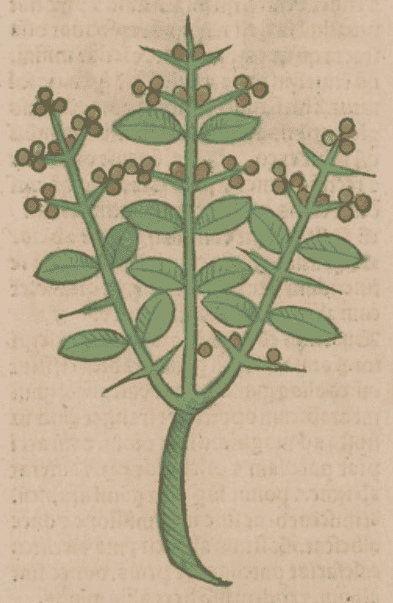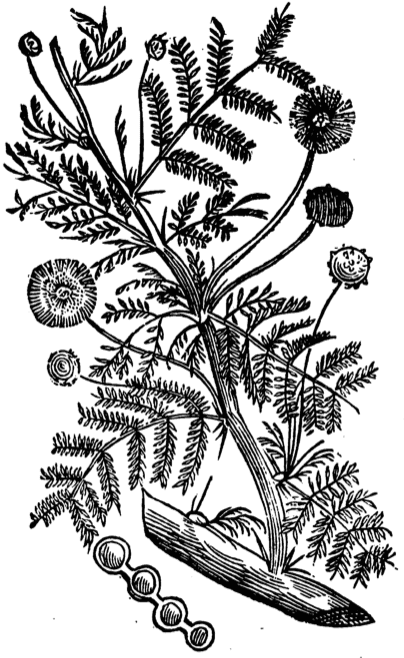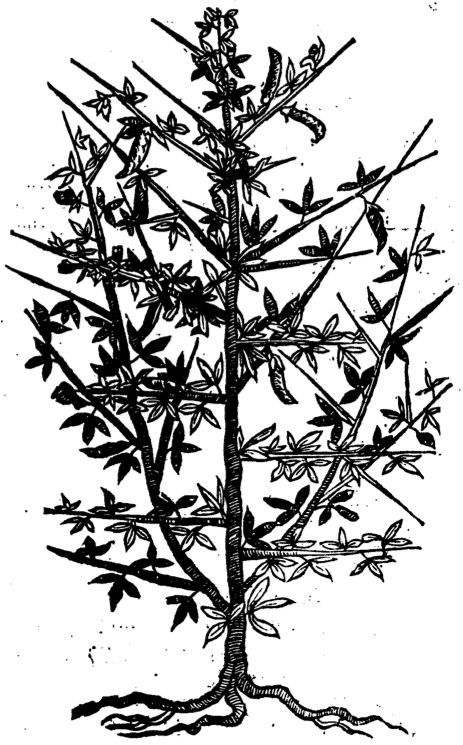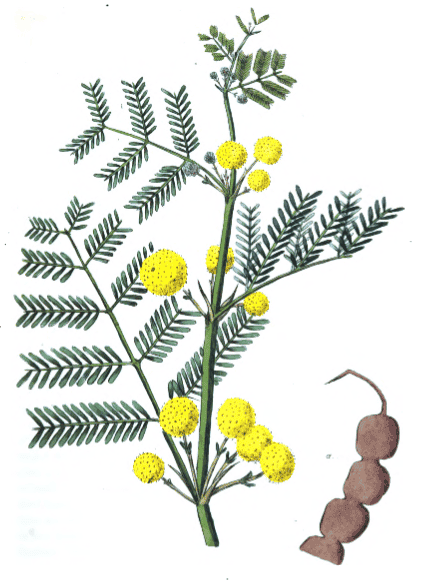Acacia, Gum Arabic
Egyptian ThornBabula (Ayurveda)
Aqaqia (Unani)
 Ortus Sanitatis, Meydenbach, 1491
Ortus Sanitatis, Meydenbach, 1491

|

|
Parkinson, Theatrum Botanicum, 1640
 Flora Medica, Royal College of Physicians, 1829
Flora Medica, Royal College of Physicians, 1829
Members CLICK HERE for the PRO VERSION
Botanical name:
Acacia arabica
Parts used:
Gum (‘Gum Arabic’); extract of the seed pods (‘Gum Acacia’)
The bark is also used in Unani medicine
Temperature & Taste:
Neutral (some said Cool), moist in the 1st degree
It thickens
Classifications:
2E LENITIVE. 2G. CLEANSING. 2O. ASTRINGENTS. 2P. HEMOSTATICS. 2S. STRENGTHENING MEDICINES
3F. LITHONTRIPTIC
4d. PECTORAL. 4e. STOMACHIC
Uses:
1. Clears Heat, Benefits Yin:
2. Benefits Yin, Strengthens the Kidneys, Restrains Essence:
DOSE:
500mg–2 grams of the Powder
Substitutes:
… available in PRO version
Main Combinations:
… available in PRO version
Major Formulas:
Syrup of Violet (De morbus internis curandis)
Tragacanth Cooling Powder (Diatragacanth Frigidum) (Nicholas)
Powder of Three Sandalwoods (Diatrisantalum) (Mesue)
Powder of Haly (Haly)
Aromatic Rose Compound (Aromaticum Rosatum)
Troches of Saffron (Damocrates)
Troches of Amber (Trochisci de Succino) (Mesue)
Troches of Earth of Lemnos (Trochisci de Terra Lemna)
Troches of Spodium (Trochisci Spodii) (Avicenna)
Troches of Ramich (Mesue)
Troches of Gordon (Trochisci Gordonii)
Troches for Cough (Andromachus)
Sugar Penid (Diapenidon Frigidum) (Nichoals)
Sugar Penid with Spices (Diapenidon Compositum) (Nicholas)
Abbots Confect of Rose (Diarrhodon Abbatis) (Nicholas)
A Sound and Experienced Electuary (Mesue)
Electuary of Pine Nuts (Looch de Pino) (Mesue)
Electuary to Restore Humidity (Arnold de Villa Nova)
Electuary of Poppy (Diapapaver) (Mesue)
Electuary of Micleta (Nicholas)
Restorative Electuary (Antidotus Analeptica) (Nicholas)
Lohoch of Poppy (Lohoc de Papavere)
Pills of Rhubarb (Greater) (Pil. de Raved Sceni) (Mesue)
Pills Against Fluxes (Nicolas)
Cautions:
None noted
Main Preparations used:
Powder; Mucilage; Purified Gum (dissolved in water, strained, and thickened)
-
Extra Info
-
History
|
‘The history of this drug carries us back to a remote antiquity. The Egyptian fleets brought gum from the gulf of Aden as early as the 17th century B.C. Thus in the treasury of king Rhampsinit (Ramses III.) at Medinet Abu, there are representations of gum-trees, together with heaps of gum. The symbol used to signify gum, is read Kami-en-jmnt. i.e. gum from the country of Punt. This, in all probability, includes both the Somali coast as well as that of the opposite parts of Arabia. Thus, gum is of frequent occurrence in Egyptian inscriptions; sometimes mention is made of gum from Canaan. The word kami is the original of the Greek [?], whence through the Latin our own word gum. The Egyptians used gum largely in painting; an inscription exists which states that in one particular instance a solution of Kami (gum) was used to render adherent the mineral pigment called chesteb, the name applied to lapis lazuli or to a glass coloured blue by cobalt. Turning to the Greeks, we find that Theophrastus in the 3rd and 4th century B.C. mentioned [?] as a product of the Egyptian [?], of which tree there was a forest in the Thebais of Upper Egypt. Strabo also, in describing the district of Arsinoe, the modern Fayum, says that gum is got from the forest of the Thebaic Akanthe. Celsus in the 1st century mentions Gummi acanthinum; Dioscorides and Pliny also describe Egyptian gum, which the latter values at 3 denarii [2 shillings] per lb. |
In those times gum no doubt used to be shipped from north-eastern Africa to Arabia; there is no evidence showing that Arabia itself had ever furnished the chief bulk of the drug. The designation gum arabic occurs in Diodorua Siculus in the first century of our era, also in the list of goods of Alexandria mentioned in our article on Galbanun. Gum was employed by the Arabian physicians and by those of the school of Salerno, yet its utility in medicine and the arts was but little appreciated in Europeun til a much later period. For the latter purpose at least the gummy exudations of indigenous trees were occasionally resorted to, as distinctly pointed out about the beginning of the 12th century, by Theophilus or Rogker: “gummi quot exit de arbore ceraso vel prano.” During the middle ages, the small supplies that reached Europe were procured through the Italian traders from Egypt and Turkey. Thus Pegolotti, who wrote a work on commerce about A.D. 1340, speaks of gum arabic as one of the drugs sold at Constantinople by the pound not by the quintal. Again, in a list of drugs liable to duty at Pisain 1305, and in a similar list relating to Paris in 1349, we find mention of gum arabic. It is likewise named by Pasi, in 1521, as an export from Venice to London. Gum also reached Europe from Western Africa, with which region the Portuguese had a direct trade as early as 1449.’ (Pharmacographia, Fluckiger & Hanbury, 1879) |
